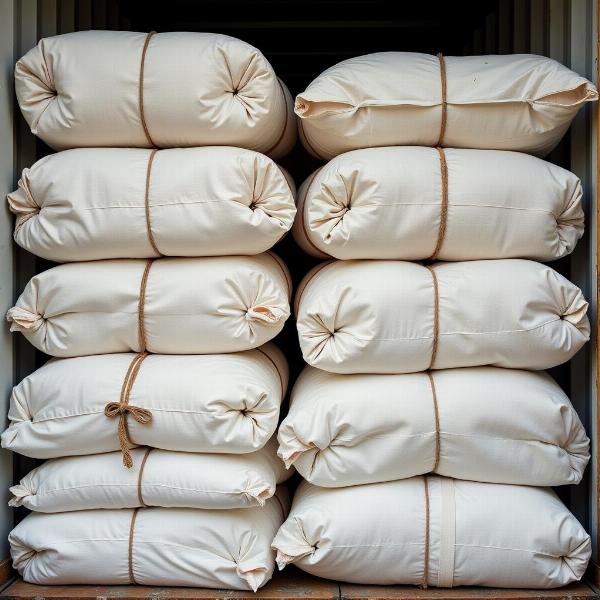Cotton lint, a crucial agricultural commodity, plays a significant role in the textile industry. Understanding its meaning in Hindi is essential for anyone involved in cotton farming, trading, or processing in India. This article delves into the various Hindi terms for cotton lint, exploring their nuances and cultural significance.
What Does Cotton Lint Mean in Hindi?
The most common Hindi word for cotton lint is रूई (Rui). This term broadly refers to the fluffy, white fibers harvested from the cotton plant. However, depending on the specific context and stage of processing, other terms might be used to describe cotton lint more precisely. For instance, बिनौला (Binola) refers to cottonseed, which is often processed to separate the lint from the seeds.
Different Hindi Terms for Cotton Lint and Their Usage
While “Rui” is the most common translation, other terms provide a more nuanced understanding:
- कपास (Kapas): This refers to the raw cotton plant itself, including both the fibers and the seeds.
- फुटा (Phuta): This term describes the opened cotton bolls, ready for picking. It emphasizes the visual aspect of the fluffy, exposed lint.
- ओटाई (Otai): This word specifically refers to the process of picking or harvesting cotton.
Understanding these terms allows for more accurate and specific communication within the cotton industry.
Why Knowing the Correct Hindi Term Matters
Accurate terminology is crucial for effective communication. Whether you are discussing farming practices, negotiating prices, or explaining technical processes, using the right Hindi word ensures clarity and avoids misunderstandings. This is especially important in a multilingual country like India, where Hindi is widely spoken in cotton-producing regions.
Cotton Lint in Indian Culture and Tradition
Cotton has a long and rich history in India. It is not merely an agricultural commodity but also an integral part of Indian culture and tradition. From handloom weaving to religious ceremonies, cotton plays a significant role in various aspects of Indian life. The Hindi terms associated with cotton reflect this deep-rooted connection.
How is Cotton Lint Processed?
The journey from the cotton plant to usable fiber involves several steps. After harvesting, the cotton bolls are dried and then ginned to separate the lint from the seeds. The separated lint is then cleaned, pressed into bales, and shipped to textile mills for further processing.
 Cotton Bales Ready for Shipping
Cotton Bales Ready for Shipping
What is the difference between cotton lint and cotton fiber?
While often used interchangeably, there’s a subtle difference. “Cotton lint” refers to the raw, ginned fibers, while “cotton fiber” can refer to both the raw lint and the processed fibers used in textile production.
Conclusion
Understanding the meaning of “cotton lint” in Hindi is essential for effective communication and successful business operations within the Indian cotton industry. This knowledge not only facilitates accurate transactions but also demonstrates respect for the cultural significance of cotton in India. By using the appropriate Hindi terms, you can bridge language barriers and foster stronger relationships with local communities and businesses.
FAQ
- What is the most common Hindi word for cotton lint? The most common word is रूई (Rui).
- What does कपास (Kapas) mean? कपास refers to the entire cotton plant, including fibers and seeds.
- What is the Hindi word for the process of picking cotton? The word is ओटाई (Otai).
- Why is it important to know the different Hindi terms related to cotton? Using precise terminology avoids misunderstandings and facilitates clear communication within the industry.
- What is the difference between Binola and Rui? Binola refers to cottonseed, while Rui refers to the cotton lint.
- What is Phuta in relation to cotton? Phuta describes the opened cotton bolls, ready for picking.
- What is the cultural significance of cotton in India? Cotton is deeply ingrained in Indian culture and tradition, playing a role in everything from textiles to religious ceremonies.
Meaning-Hindi.in is your trusted partner for all your Hindi translation needs. We specialize in various translation services, including business and commercial documents, legal and certified translations, technical manuals, website localization, and educational materials. We also offer fast and specialized translation services to cater to diverse requirements. With our expertise in business and commercial translation, we can accurately translate your cotton-related documents, ensuring seamless communication within the industry. Contact us today for accurate and culturally sensitive Hindi translations. Email: [email protected], Phone: +91 11-4502-7584. Meaning-Hindi.in offers professional and accurate Hindi translation services for all your needs.